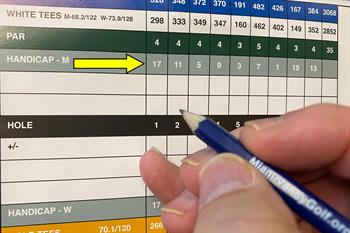 This time of year, we send out the updated ratings that our great group of highly trained volunteers spend more than 1,000 hours developing over the course of the just completed season. This time of year, we send out the updated ratings that our great group of highly trained volunteers spend more than 1,000 hours developing over the course of the just completed season.
Our recently rated courses receive their new course ratings and slopes and beginning in 2020 when the World Handicap System went into place, they also receive their suggested Stroke Index Allocation (formally known as Handicap Hole Allocations). These numbers, from 1 to 18, are assigned to each hole and generally receive a great deal of discussion. Ultimately the course can do as they wish as the relevance to the development of one’s Handicap Index is almost negligible, HOWEVER, in a Net Match Play format they can often be very important as some form of currency is often on the line. In explaining how these numbers are assigned to certain holes, most golfers believe they are assigned by the hardness of the hole. In the recommended system, this is NOT THE CASE! Stroke Index Allocations are not based on which hole is the toughest, but where the less skilled player needs the most help. Therefore, you often see the longer holes with lower numbers and the shorter holes with higher numbers because lower skilled golfers generally have more opportunity to make mistakes when playing longer holes. The old method of determining these Allocations was very burdensome as it required facilities to develop a scoring average for each hole from two groups of players, the lowest handicap players, and the highest handicap players from both genders. This process often could take months and potentially be debated for even longer. The World Handicap System now recognizes that burden and if adopted will remove the course workload as the information is developed by our Course Raters in rating the course obstacles and yardage factors along with these other factors below. The Front Nine will be Odd Strokes, the Back Nine will be Even Strokes Specific strokes will be allocated using three-hole clusters, with the #1 and #2 stroke holes in the middle cluster. Spreading stroke index allocations evenly over the 18 holes to give the best chance of strokes being received by a player prior to a match ending. Applying the second lowest stroke index hole (3 or 4) on each nine in either the 1st or 3rd triad unless the lowest stroke index hole has been allocated in that same triad. When possible, to avoid consecutive low stroke indexes (6 or less) on consecutive holes. Remember when applying Higher Handicaps allocations for strokes 19-36 and 37-54 simply repeat the order of the stroke index allocation. (e.g. Stroke Index Allocation Hole Ranked #1 receives two strokes from a Playing Handicap of 19) And for the matches that might go extra holes the recommendation is to continue having the difference in the Playing Handicaps which is the way the entire match should be played, IE when a 19 is playing a 18, the 19 only gets one shot on the #1 Stroke Index Allocation Hole.
On closing, one of the greatest things about our game is its social aspect, and whether to use what the World Handicap System recommends or what your committee decides almost certainly instigates conversations around Stroke Index Allocations. | 
 This time of year, we send out the updated ratings that our great group of highly trained volunteers spend more than 1,000 hours developing over the course of the just completed season.
This time of year, we send out the updated ratings that our great group of highly trained volunteers spend more than 1,000 hours developing over the course of the just completed season. 